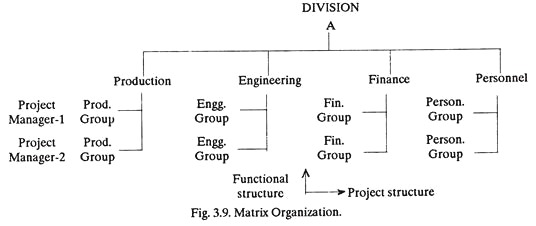After reading this article you will learn about:- 1. Concept of Matrix Organisation 2. Advantages of Matrix Organisation 3. Limitations.
Concept of Matrix Organisation:
Matrix organisation is used when an organisation has to handle a Variety of projects, ranging from small to large. When a pure project structure is superimposed on a functional structure, the result is a matrix structure. In other words, the matrix organisation is a project organisation plus a functional organisation.
The project structure provides a horizontal lateral dimension to the traditional vertical orientation of the functional organisation structure (Fig. 3.9).
To conclude, matrix organisation is created by merging (two complementary structures, namely) pure project organisation and functional organisation. The project teams are composed of persons drawn from the functional departments for the duration of the project. When their assignment is over, they return to their respective departments. During continuation of the project, such persons have two bosses – one, from the functional department and second of the concerned project.
Advantages of Matrix Organisation:
(i) If effectively focuses resources on a single project, permitting better planning and control to meet deadline.
(ii) It is more flexible than a traditional functional hierarchy.
(iii) Services of specialists are better utilized as more emphasis is placed on the authority of knowledge than rank of the individuals in the organisational hierarchy.
Limitations of Matrix Organisation:
(i) Matrix organisation violates the principle of unity of command as a person works under two bosses e.g., project manager and functional boss. This may give rise to conflicts in the organisation.
(ii) Organisation relationships are more complex and they create problems of coordination.
(iii) Since persons are drawn temporarily from different departments, project manager does not have line authority over them.
(iv) Project group is heterogeneous and due to which morale of the personnel may be low.
